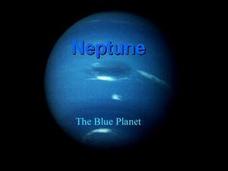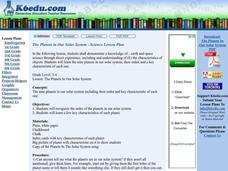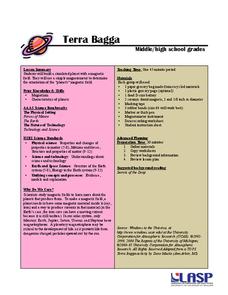Curated OER
Characteristics of the Outer Planets
A brief reading comprehension exercise, this worksheet covers the characteristics of the outer planets. It still considers Pluto a planet and Charon its moon. It is therefore a little out of date, but this fact can be discussed as part...
Curated OER
Neptune: The Blue Planet
A lovely space science PowerPoint teaches learners about the discovery and characteristics of the planet Neptune. The slides show real photographs, along with clear descriptions about Neptune. This PowerPoint is beautifully done with...
Curated OER
Charting Neptune's Realm:
Students explore how to construct and interpret maps and globes and find information about people, places, regions, and environments.
University of Colorado
Space Travel Guide
Neptune takes 164.8 Earth years to travel around the sun. In the fifth of 22 lessons, young scientists create a travel guide to a planet in our solar system. They provide tips for others on what to bring, what they see, and their...
Curated OER
CHARTING NEPTUNE'S REALM
Students design a twenty-first century book cover based on the concepts and designs of the eighteenth century.
Curated OER
The Planets in our Solar System
Students learn the order and key characteristics of each planet in our solar system. In this solar system lesson, students work in groups to characterize each planet on an index card. They use their index cards to put the planets in...
Curated OER
Exploring Dwarf Planet Eris
In this planet Eris worksheet, students read about the discovery of this dwarf planet and its characteristics. Students answer 3 questions about the planets, the classification of planets and the definition of planets. Students define 7...
Curated OER
Planet Cards
In this science card worksheet, students cut out the different cards and study the planets Earth, Venus, Mercury, Saturn, Jupiter, Mars, Pluto, Neptune, and Uranus. Students' objective is to learn each planets' orbit, rotation, distance...
Curated OER
The Planets in Our Solar System
Learners gain knowledge about earth and space science by studying the nine planets in the solar system as well as their key characteristics. In this solar system lesson, students identify the nine planets. Learners work in groups to...
Curated OER
Introduction to the Planets
Students become familiar with the members of the solar system and planetary order. They identify differences and characteristics of individual planets. Finally students visualize the great size of the solar system and make the image more...
Curated OER
Greek Mythology
Ninth graders examine the characteristics of Greek Mythology. For this World History lesson, 9th graders study the connections between Greek Mythology and the Universe.
Curated OER
Our Solar System
Students study the Earth and Solar System through a variety of activities. They compile a coloring book show the characteristics of the Sun and nine planets.
Curated OER
What's "Out" There?
First graders investigate the five outer planets. In this space science lesson plan, 1st graders read the book Our Solar System and identify the five outer planets. Students create a booklet and write about outer planets.
Virginia Department of Education
Solar System Model
How many planets can you name? Did you get all 13 in our solar system, including the dwarf planets, or were you surprised when you read there are 13 planets? The lesson plan helps scholars understand the scale of the universe including...
Virginia Department of Education
Planet Line-Ups
Should Pluto be considered a planet or a dwarf planet? Scholars research planets in our solar system to understand their similarities and differences. It also includes memory activities related to the order of the planets.
University of Colorado
Terra Bagga
Earth's magnetic poles switch positions about every 200,000—300,000 years. In the activity, groups create a planet with a magnetic field. Once made, they use a magnetometer to determine the orientation of the planet's magnetic field....
University of Colorado
Terra Bagga
One way to identify possible volcanic activity on other planets is by testing the planet for magnetism. A science lesson plan begins with pupils constructing their own planet from a dead battery, magnets, paper, and tape before...
Curated OER
The Map Cartouche
Students discuss the history and purpose of cartouches. They examine examples of cartouches and design an original example with symbols of their choosing.
Curated OER
Chart Making for Navigators
Students discuss the importance and function of nautical maps for sailors. They, in groups, take soundings of a simulated bay in a shoebox and develop a nautical chart that enable them to navigate the shoebox safely.
Curated OER
Solar System Hall Model
Not novel, but fun, this instructional activity gets your space science learners to model the size of the planets and the solar system along your school's hallway. Scaled measurements as well as actual distances are provided for both...
Curated OER
The Outer Planets
In this planets learning exercise, learners research the diameters and sizes of the planets. Then student will create scale model sizes of the planets out of cookie dough. Students complete 5 short answer questions.
Curated OER
Our Place in Space
Third graders identify the different planets that make up the solar system. In this space science lesson plan, 3rd graders construct a scale model of the major planets. They explore their different unique features and dress up as planets.
Curated OER
Charting The Planets
Students conduct different activities in order to unlock the secrets of the universe. They answer different questions that are written to assess knowledge of the planets. Information can be found on the internet to help.
Curated OER
Solar System
Second graders create planet mobiles in order to reinforce concepts such as planet size, position in relation to the sun, and planet names.

























